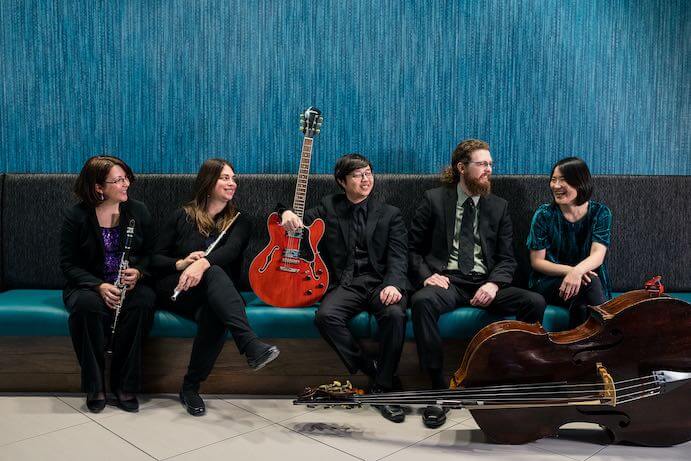In the world of visual art, perspective is what shows us how objects in a piece are related; it’s the illusion that a two dimensional representation actually occupies a three dimensional space. Perspective is also one of the principles of art that translates least well to music. Although musical descriptions often leverage spatial metaphors to help listeners imagine musical lines interacting, metaphors can only suggest or imply, never quite able to state the relationships outright. But the commissions comprising fivebyfive’s 2021 release Of and Between use art as a springboard, framing their sounds in a visual context that forges an uncommonly strong connection between music and image.
Of and Between offers two sets of art-inspired commissions, plus a bonus track by Anthony R. Green. The Choreograph Collection – by Kamala Sankaram, Robert Lydecker, and Yuanyuan (Kay) He – translates a series photographic prints by James Welling into a musical triptych. Each of Welling’s prints overlay three dynamic images of dancers through contrasting color channels, depicting the creative process from inspiration to rehearsal to polished presentation.
Meanwhile, interpretations of Judith Schaechter’s “The Battle of Carnival and Lent” make up the Glass Works Collection, featuring composers Edie Hill, Jung Sun Kang, Jon Russell, and Andrea Mazzariello. Schaechter’s piece (based on a Renaissance piece of the same name) depicts the tension between spirituality and suffering using a crowd of characters both grotesque and celebratory. With Laura Lentz on flute, Marcy Bacon on clarinet, Sungmin Shin on electric guitar, Eric Polenik on bass, and Haeyeun Jeun on piano, the ensemble’s irregular instrumentation offers an infinitely variable timbral palette that the commissioned composers exploit enthusiastically.

A standout of the Choreograph Collection is Kamala Sankaram’s Dancing About Architecture. Upon first seeing Welling’s “Choreograph,” Sankaram was struck by dancers’ placement against a backdrop of brutalist architecture, reminding her of the quote, “Writing about music is like dancing about architecture.” From these words spoken aloud, Sankaram extracted frequencies that would be translated to pitch and rhythm. The resulting groove is the piece’s foundation, but once the listener has settled comfortably into the rhythm of quasi hocketed entrances, Sankaram adds intrigue with subtle interruptions. Lentz’s flute lines are cooly reserved throughout, but her attention to timbre and articulation, paired with Sankaram’s careful organization of partial-ensemble textures, erupt rapidly into head-banging peaks.
Like Sankaram’s piece, Kay He’s BOKEH also captures Welling’s distorted cityscapes, illustrating them with booming, reverberant dissonances and brooding solos by Shin and Lentz. Yet the lighter moments of “Choreograph” – images in saturated oranges and bright lime greens, depicting dancers in motion – are also present in the commissions. In Robert Lydecker’s It Can’t Not Be Dance Music, the transition from stuttering and disjunct rhythms into ecstatic, tumbling scalar passages suggests serenity more than tension. As Welling’s architecture fades, the kneeling, lunging, spinning dancers dramatize uncertainty, then verve.
Of the Glass Works Collection, Jon Russell’s Procession and Burlesque is particularly captivating. Russell translates the conflicting moods of Schaechter’s “Carnival” and “Lent” into separate movements, offering a narrative to the static original: “If the artwork depicted a single snapshot,” Russell asks, “what might have led up to this moment – and what would come after?” Just underneath the flute and bass clarinet’s hymn in octaves, Shin provides a pitchless, strummed pulse, calculated and brooding. Upon the switch to the shockingly fast burlesque, however, the satisfying snarl and bite of Bacon’s bass clarinet grounds what Russell aptly calls a “manic carnival.”

While Russell embraces Schaechter’s contrasts, the rest of the Glass Works Collection aims to mediate them: the composers work to express Schaechter’s uncanny juxtaposition between the holy and the hellish without moving too deeply toward one or the other. While Edie Hill’s Blue Jewel balances these two extremes with soloistic passages interspersed with abrupt interjections from other instruments, Jung Sun Kang’s Manhattan and Andrea Mazzariello’s Of and Between opt to build out lush ensemble textures, perhaps reflective of the contemplative mood Schaecter hoped to create. Though both the music and the art offer fine details, Schaechter’s positioning of the characters as a mass following a sinuous curve allows the composers to zoom out, or to consider them in the aggregate.
The album is permeated by a film noir sensibility; each member of fivebyfive excels at evoking an atmosphere of mystery and suspense, in synchrony with the works of art they aim to enliven. Even in moments of optimism, as in the opening of Anthony R. Green’s …a tiny dream…, bassist Polenik’s sharp pizzicato accents add a twinge of dread. Regardless, however, of the generally ominous mood, Jeun and Polenik’s moment-to-moment flexibility thwarts any notion of staleness, and the ensemble’s gradient of change proves nuanced throughout.
The millennia-long relationship between visual art and music has produced unlikely translations, from Guillame DuFay’s musical representation of a cathedral to Caroline Shaw’s Partita for 8 Voices based on work by Sol LeWitt. Even when it isn’t paired with art, music is always intertextual. But in projects like fivebyfive’s Glass Works and Choreograph Collections, where the connections between works (and people and ideas) are foregrounded rather than left latent, it’s easier to feel grounded in a reaction that’s not just personal, but communally shared.
I CARE IF YOU LISTEN is an editorially-independent program of the American Composers Forum, funded with generous donor and institutional support. Opinions expressed are solely those of the author and may not represent the views of ICIYL or ACF.
A gift to ACF helps support the work of ICIYL. For more on ACF, visit the “At ACF” section or composersforum.org.
























